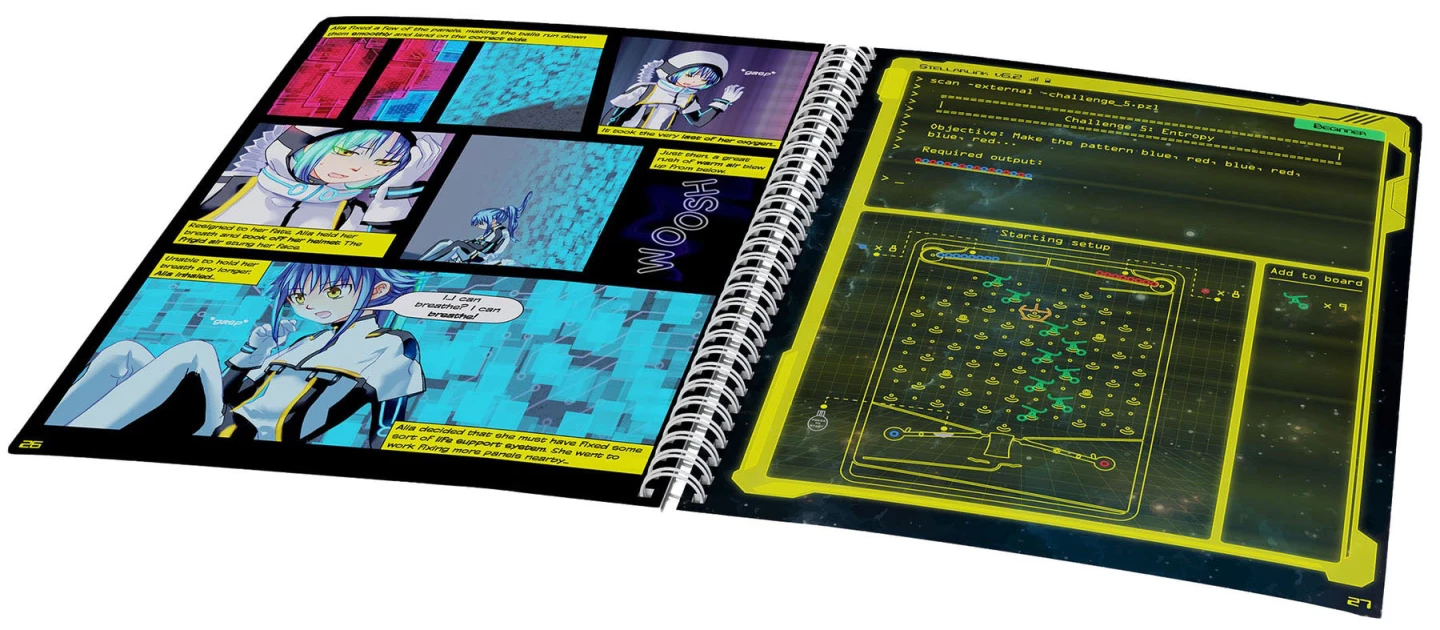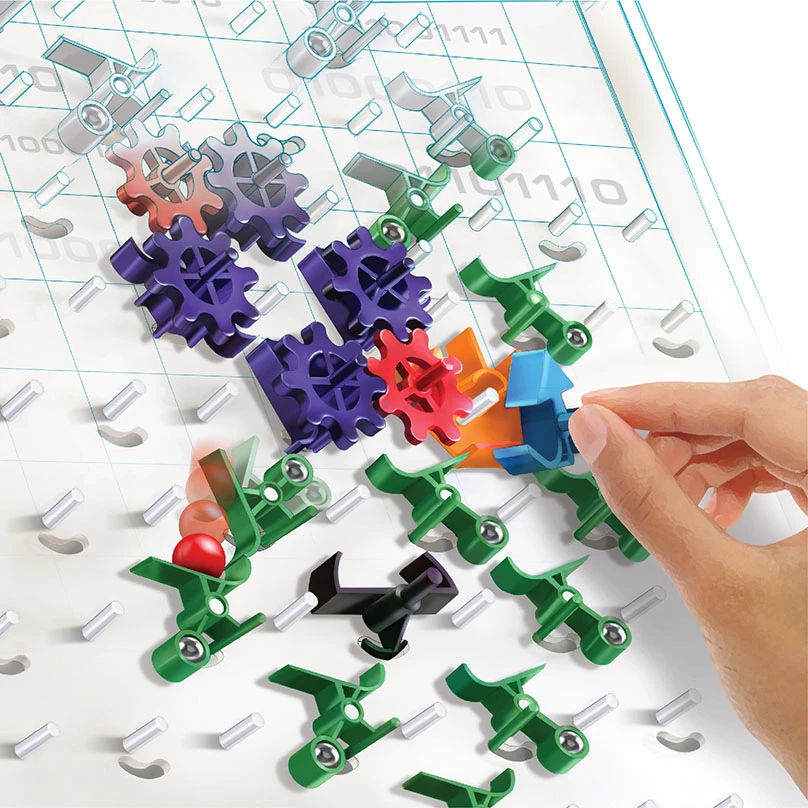Minnesota company Upper Story has sent us its Turing Tumble, a fascinating educational toy that quietly tricks kids into inventing binary logic computers using nothing more than tiny marbles dropping through a series of clicky-clacky plastic pieces.
The theory here is this: not many people understand how they work on a basic level, but computers pretty much rule our lives at this point. They certainly rule the life of my eight-year old son Max, who merrily plans his days first and foremost around the time limits we've placed on his mobile device and PlayStation usage. He's a pretty clever cookie with a general interest in how things work, so we thought he'd be a good candidate to lock in a room with a Turing Tumble to see if it successfully morphed him into the kind of genius upon whose spectacular earning power we should be able to retire.
I placed the Turing Tumble in front of him, told him it would allow him to build marble-based computers, and watched carefully to see his reaction. He glanced at it, then went back to his game of Mineshaft or whatever and said "later." But I am nothing if not a strategist, so I put him in a car and took him several hours from an internet connection, and tried again. He opened the box. Great success!

A confusing array of colored pieces lay within, as well as a very nicely put together graphic novel, a large, white, plastic board with pins and slots and ramps in it, and a little bag full of tiny marbles. These, I assumed, would shortly be rattling their way up the nozzle of the vacuum, having all been lost in the carpet. I put the main board together, adding a set of weighted flippers at the bottom, linked to marble-releasing jiggers up the top, and set it in its stand.
Meanwhile, Max was flipping through the graphic novel. This tells the story of a young astronaut called Alia, who finds herself crash-landing her spaceship on an alien planet, where she discovers some sort of ancient machine in a state of disrepair, as well as a number of functional parts lying around. She begins to fix it.
This story, of course, is nothing but a clever ruse designed to ensnare children, teach them the rules of the logic board and give them an emotionally compelling reason to solve a bunch of puzzles. Max, being suitably emotionally compelled, quickly began solving the puzzles.

Each puzzle begins with a certain number of marbles at the top – blue ones on the left, red ones on the right – and a certain number of pieces pre-positioned on the board. You are given a certain number of other pieces you can put in, as well as a desired result.
The pieces are extremely simple. Green "ramps," for example, can simply direct the ball left or right as it drops through the grid, depending on which way you point them. Orange "crossovers" can accept a marble from either direction, and will send it out the other side. Black "interceptors" simply catch and stop the marble. When the ball gets to the bottom, it goes through one of two levers, depending on how you've guided it. The left lever is connected to the blue ball release mechanism, the right to the reds
Things get more interesting when you start encountering blue "bits." These change states each time a marble runs through them, and send the marble out in a different direction each time. They are called bits, because they indeed represent the "binary digits," or bits, the ones and zeros, which form the basic units of information upon which computers are built and programmed.
Before too long, I found Max looking at an array of four bits, one on top of the other. Surrounded with the right pieces, they formed a four-bit binary register capable of counting to 15. And at this point I'll admit, as a 45-year-old technology writer, this was a light bulb moment: it was the first time I ever truly understood how binary numbers worked, or had a genuine physical sense of what 8-bit means, other than funky retro video game music.

As I marveled at this covert piece of education, Max appeared entirely unaware that he was learning anything at all. But he was; he was learning to set initial system states and trace a path through multiple iterations, each run giving the correct result in terms of which color ball was released next, what state the bits were left in, and what color balls were going through to the final array at the end. He was working out that once a register was set up properly, he could use binary counting as a shortcut rather than running his finger through the puzzle 10 times.
But Max was more wrapped up in Alia's story; she'd worked out that the ancient machine she was repairing was some sort of mechanical supercomputer capable of synthesizing speech. To begin with, it was only able to say "NO NO NO NO NO," and Max happily busied himself by giggling "NO NO NO NO NO" until my head nearly exploded.
I think the man himself should take it from here for a bit, so I asked Max for his thoughts.

"One second, let me see how skinny I am in the mirror. Don't write that! Stop! Ugh, fine.
"The Turing Tumble is an amazing marble-powered computer that works differently each way you create it. This is all related to actual computers. I think the ramps represent wires. Interceptors, well, they intercept things. I haven't really figured out bits yet, but I know the registers are binary counters. I can count in binary up to any number now, if I have enough bits. Gear bits are bits with cogs. They can change each other. So if you run a ball through one, they change, but if you run it through two, the second one will reset it. Normal bits can't do that. My guess is the marbles somehow represent some kind of energy or information.
"It's a good story. It's an amazing story. It helps you understand the challenges. Otherwise, you'd be like 'ugh, this is a book of challenges. Why the heck am I doing these challenges?' I like the bit after you complete the crossovers, where Alia's trying to fix the computer and it starts talking. Its comments are not very positive. It says 'NO NO NO NO NO NO!'
"It's a way you can learn about the inside of computers without actually knowing that you're learning any frickin' thing. It's fun as well. But as the book says, do not let balls drop freely, or like Dad says, you'll find them rattling up the nozzle of your vacuum. I have fun stuffing around with the gear bits.
"One thing that annoys me ... You can run your finger down the Turing Tumble to test it, or just look at it and try and test it in your mind. Except sometimes when I'm testing it in my mind I get it completely wrong and balls land on the floor. Somehow, I've chased them all down and none have gone up the nozzle of the vacuum. But some did go under the piano.
"I've worked my way up to challenge 33. It's hard to describe to people that haven't got a Turing Tumble, or haven't got up to this challenge. I've looked at the final challenges, and they start off with nothing on the board, you have to build the computer from scratch. That's nuts. I can't think of anything to say next, how do you do this all day Dad?
"I did some challenges while Dad was writing this review. I was doing a puzzle, and sometimes the ramps and the levers didn't want to flip the right way. It turns out, it was just the stand at the back of the board being annoying, Dad stuck it in properly and everything worked again. Hey, we sure got some funny bits in this review! Maybe this will boost the amount of people actually buying these toys. Wait, don't write that! Now excuse me, it's 6:03 pm and my phone time is starting to run out."

We're only a little over half way through the book, and I have to say I'm pretty impressed with what Upper Story has built here. The Turing Tumble is a charmingly physical and tactile way of introducing difficult and intangible digital concepts. When Max figures out the challenges by himself, he's generally stoked enough to go and grab someone – anyone – and show them as it clicks its way to a conclusion in a satisfying manner. His four-year-old sister dutifully stands and watches the machine work, with no idea what's going on, and she decides whether to clap or not based on how stoked Max looks at the end.
When he gets stuck and grabs me for help, it's no small task catching up and figuring out where he's gone wrong, and I'm suitably stoked myself when things work as planned. It's clear that this thing has been put together by very clever people – and equally clear that a lot of love and thought has gone into it. It's a pretty remarkable jigger.
Before too long, Max will be building physical logic machines driven solely by the mechanical energy of falling marbles that can add, subtract, multiply and divide. If you made the Turing Tumble big enough – about the size of Texas, according to Upper Story – you'd have a computer as powerful as the average desktop, albeit aeons slower. The takeaway for kids is this: put enough switches in the right configuration, and you can do some pretty incredible things. Transistors are just super-fast switches controlled by electricity, and they're the foundation of every digital device you know and love.
But at the heart of it, does the Turing Tumble do what buyers are hoping it will? I ask Max if he's now going to become an incredibly rich genius whose colossal fortune we can soon live off in comfort and style. "I don't know," he replies. "I can't tell my future, or anyone else's." I tell him that's totally the sort of thing an incredibly rich genius would say. "Or just a genius," he points out. Goddamnit, he's right.
The Turing Tumble is available directly from Upper Story at a very reasonable US$69.95. Check out Max using it as a subtraction machine (and attempting several times to eat it) in the video below.
Source: Upper Story












